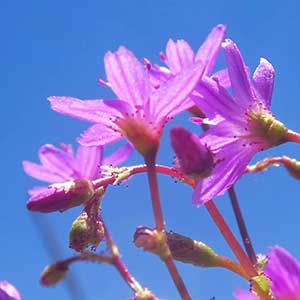Lewisia leeana
Lewisia oppositifolia
many flower lewisia, quill-leaf lewisia
opposite-leaf lewisia
gradually ramified distally.
gradually ramified distally.
spreading or suberect, 8–20 cm.
erect, basal nodes underground, 10–20(–25) cm.
basal leaves evergreen, sessile, blade linear, ± terete, 1.5–6 cm, margins entire, apex obtuse;
cauline leaves alternate, intergrading with bracts, blade narrowly lanceolate, 5 mm, margins entire, apex acute.
basal leaves withering at or soon after anthesis, abruptly narrowed into broad petiole, blade linear-spatulate to linear-oblanceolate, flattened, 4–11 cm, margins entire, apex obtuse to subacute;
cauline leaves opposite, in 1–3 pairs near stem base, smaller than and similar to basal leaves.
paniculate cymes, 50–70(–100)-flowered;
bracts several, alternate proximally, 2 at each flowering node distally, ovate to narrowly lanceolate, 2–5 mm, margins glandular-toothed, apex acute.
racemose to subumbellate cymes, (1–)2–5(–6)-flowered;
bracts alternate proximally, 1–many at each flowering node distally, lanceolate, 4–8 mm, margins entire or toothed at apex, apex acute to acuminate.
pedicellate, not disarticulate in fruit;
sepals 2, suborbiculate, 1–4 mm, herbaceous at anthesis, margins glandular-toothed, apex truncate;
petals 5–8, magenta, lavender, or white with or without magenta veins, obovate, 5–7 mm;
stamens 4–8;
stigmas 2;
pedicel 3–15 mm.
pedicellate, not disarticulate in fruit;
sepals 2, suborbiculate, 4–8(–10) mm, herbaceous at anthesis, margins coarsely toothed but not glandular, apex obtuse to rounded;
petals 8–11, pink fading to white, oblanceolate to obovate, 9–15 mm;
stamens 8–18;
stigmas 3–5;
pedicel 20–75 mm.
4–5 mm.
5–6 mm.
1–2, 2–2.5 mm, shiny, smooth.
5–15, 1–1.8 mm, shiny, smooth.
= 14.
Lewisia leeana
Lewisia oppositifolia
Lewisia leeana is known only from northwestern California and southwesternmost Oregon, and a disjunct population in Fresno County, California. As discussed by B. Mathew (1989b), Lewisia ×whiteae Purdy (California) is a natural, constantly recurring hybrid between L. leeana and L. cotyledon. In their narrowly spatulate leaves, the hybrids resemble L. columbiana out of range (cf. L. T. Dempster 1993); the flowers are reportedly more deeply colored.
(Discussion copyrighted by Flora of North America; reprinted with permission.)
Lewisia oppositifolia is known only from Del Norte County, California, and Josephine County, Oregon.
The floral symmetry of Lewisia oppositifolia may be somewhat elliptical, the outer two petals alternating with the sepals and the remaining petals imbricate and opposite the sepals, giving the flowers a pinched appearance, a feature also reported for L. nevadensis. The more diminutive, higher-elevation plants of L. oppositifolia possibly represent a distinct taxon that has been informally recognized as “Lewisia richeyi” (B. Mathew 1989b).
(Discussion copyrighted by Flora of North America; reprinted with permission.)


